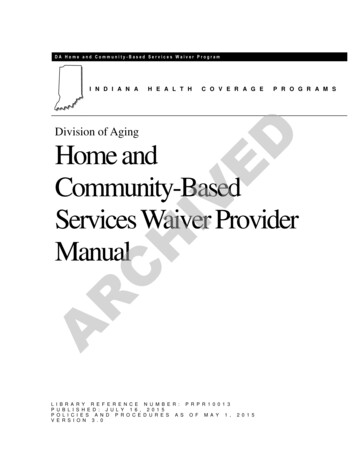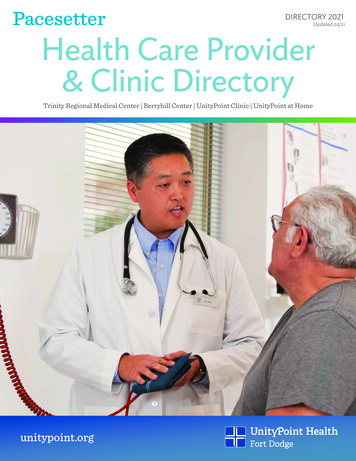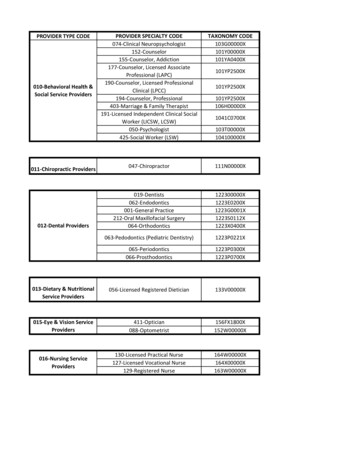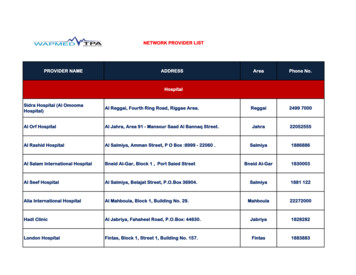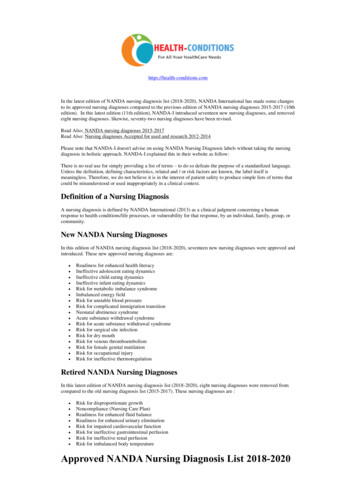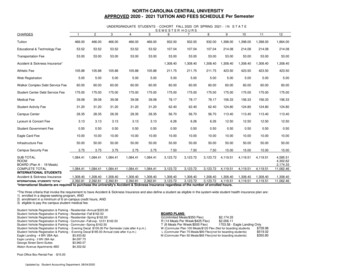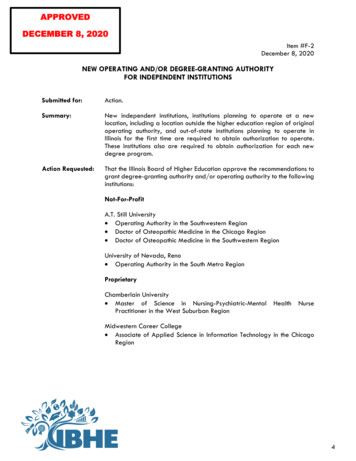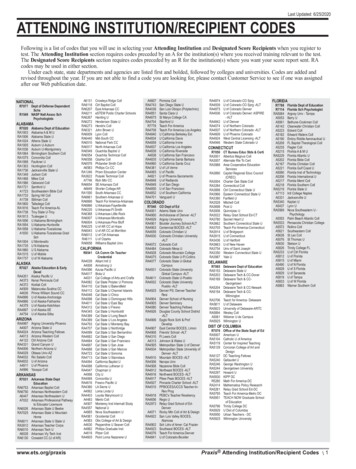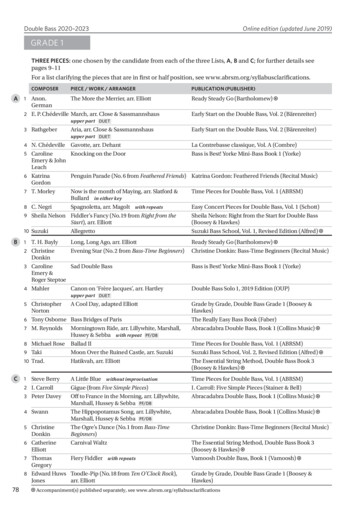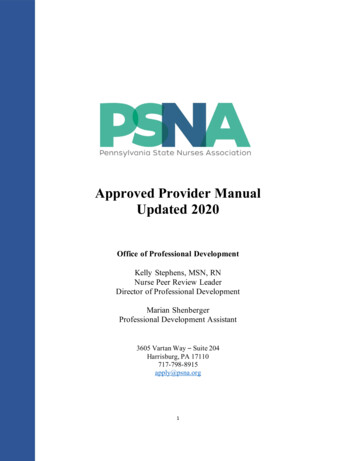
Transcription
Approved Provider ManualUpdated 2020Office of Professional DevelopmentKelly Stephens, MSN, RNNurse Peer Review LeaderDirector of Professional DevelopmentMarian ShenbergerProfessional Development Assistant3605 Vartan Way – Suite 204Harrisburg, PA 17110717-798-8915apply@psna.org1
Introduction . 4Section I: The Application Process . 5Step 1: Approved Provider Eligibility. 5Approved Provider Eligibility Form . 6Step 2: The Application Process . 7Approved Provider Application/Required Documentation. 7Organizational Overview (OO) . 7Structural Capacity (SC) . 7Educational Design Process (EDP) . 8Structural Capacity (SC) . 8Educational Design Process (EDP) . 9Quality Outcomes (QO) . 11Submitting Your Application . 12Application Review Process. 12Approval Decision Process . 13Fees. 13Section II: EDP . 15Activity Types. 15Steps to Designing Your Activity. 15Conflict of Interest (COI). 18Resolution of COI. 20Commercial Support and Content Integrity . 22Section III: Approved Provider Responsibilities . 24Approved Provider Responsibilities: . 24Recordkeeping. 242
Glossary (Defined by ANCC) . 27References: . 303
IntroductionThis manual provides instructions on how to become an Approved Provider of NursingContinuing Professional Development (NCPD) through the Pennsylvania State NursesAssociation.1. Information in this document is obtained from the 2015 Primary AccreditationApprover Application Manual, published by the American Nurses Credentialing Centerand also reflects revisions of American Nurses Credentialing Center (ANCC)Accreditation in NCPD criteria and requirements for providers of NCPD.2. The Approved Provider Unit (APU) must have the authority to assess, plan,implement, and evaluate NCPD activities and operate APUs using ANCCAccreditation Program criteria.3. The APU is responsible to assess, plan, implement and evaluate NCPD activities.They are NOT authorized to approve activities developed by others withoutinvolvement of an Accredited Approver Unit.4. Commercial entities cannot be providers or joint providers of NCPD activities.5. Employees of commercial entities cannot be planners or presenters for activities inwhich the content is related to the products or services of the company.Approval as a provider of NCPD is recognition of a Provider Unit’s (PU) capacity to demonstrateexcellence in providing evidence-based content based on ANCC criteria. Your organization,upon achieving approval as an APU, is authorized to assess, plan, implement, and evaluateNCPD activities according to the criteria and award contact hours for those activities. The APUmay offer an unlimited number of educational activities during the three-year period ofapproval. Provider Units do not have the authority to approve their own or anyone else’sactivities.The terms “approved,” “application,” or “applicant” should never be used in connection withany NCPD activity the APU plans and presents.NCPD activities provided by the APU must be related to professional development of the nurse.Activity content should enable the learner to acquire or improve knowledge, skills and/orpractice beyond basic knowledge and enhance professional development or performance as anurse.NCPD activities include but are not limited to courses, seminars, workshops, lecture series,distance learning activities (audio/video conferences), web-based enduring materials, journalclubs, learner directed independent study activities or point of care learning. Knowledge anduse of adult learning principles should be reflected in all aspects of the educational design.4
Section I: The Application ProcessStep 1: Approved Provider EligibilityA Provider Unit is defined structurally and operationally as the members of an organization whosupport the delivery of NCPD activities. The Provider Unit may be a single focused organizationdevoted to offering NCPD activities or a separately identified unit within a larger organization.The Provider Unit may be placed within the education/professional development departmentof a hospital or school of nursing.The applicant applying for approval is the Provider Unit, not the organization. Provider Unitsassess learners’ needs and plan, implement, and evaluate NCPD activities according to thePennsylvania State Nurses Association guidelines, which are based on ANCC accreditationcriteria.Provider Units are responsible for developing individual education activities and awardingcontact hours to nurses for use in fulfilling their own goals for professional development,licensure, and certification. Each NCPD activity is led by a Nurse Planner (NP) in collaborationwith at least one other planner. Contact hours may not be awarded for activities developedwithout the direct involvement of a NP. PUs may jointly provide activities, but they may notapprove activities.To be eligible to apply for Approved Provider status, an organization must: Be one of the following:o ANA Organizational Affiliateo Constituent and State Nurses Association (C/SNA) of the American NursesAssociation (ANA)o College or Universityo Healthcare Facilityo Health-Related Organizationo Multidisciplinary Educational Groupo Professional Nursing Education Groupo Specialty Nursing OrganizationBe operational for a minimum of six months prior to applicationBe administratively and operationally responsible for coordinating the entire process ofassessing, planning, implementing, and evaluating NCPD activitiesNot be a commercial interest entity (an entity that produces, markets, resells, ordistributes healthcare goods or services consumed by or used on patients or an entitythat is owned or controlled by an entity that produces, markets, resells, or distributeshealthcare goods or services consumed by or used on patients).Identify one NP who will act as the Primary Nurse Planner (PNP) and serve as the liaison5
between the Pennsylvania State Nurses Association and the APU.The PNP must:o Hold a current, unrestricted license as an RN and a baccalaureate degree orhigher in nursingo Have authority within the organization to ensure compliance with ANCCaccreditation criteriao Be accountable to the Nurse Peer Review Leader (NPRL) at PSNA for all APUactivitieso Ensure that all NPs in the APU hold current valid licenses as RNs with abaccalaureate degree or higher in nursingo Be responsible to orient, educate, and monitor all APU NPs ensure that eachNCPD activity has a qualified NP who is an active participant in the planning,implementing, and evaluation processThe target audience for at least 51% of the APU’s educational activities must be withinor contiguous to the unit’s geographic region -offices/ for map).Compliance is required with all applicable federal, state, and local laws and regulationsthat affect the organization’s ability to meet CNA’s guidelines.Disclose previous denials, suspensions, and/or revocations received from other ANCCAccredited Approver Units and/or other accrediting /approving organizations.Initial applicants must contact the NPRL at apply@psna.org and have completed theprocess of assessment, planning, implementation, and evaluation for at least threeseparate individual educational activities within the last 12 months that have beenapproved by the Pennsylvania State Nurses Association or another ANCC AccreditedApprover that:o Demonstrate active involvement of a NPo Shows adherence to current ANCC accreditation criteriao Were each a minimum of one hour (60 minutes) in length were not jointlyprovidedApproved Provider Eligibility FormThe Approved Provider Eligibility Form is utilized to verify that organizations applying tobecome an Approved Provider of NCPD are eligible under ANCC eligibility requirements.Organizations deemed ineligible will not be considered for approval by the Pennsylvania StateNurses Association.This form requests information on the applicant’s demographic data and the type oforganization. All questions must be answered to determine eligibility.6
Retrieve the Approved Provider Eligibility Form at www.psna.org.Complete the form as identified and submit to apply@psna.org.You will receive notice when the form has been reviewed and you are eligible toproceed with the Approval application process. If there are any questions about youreligibility, you may be asked to submit further information to be reviewed.Once eligibility has been confirmed, make an appointment for a phone consultationwith the NPRL to review the application process and be sure your questions areanswered.Step 2: The Application ProcessApproved Provider Application/Required DocumentationStep 1: Download the Approved Provider Application from www.psna.org.Step 2: Read the entire application to be sure you understand the requirements. NOTE: It is theresponsibility of the PNP to complete each section with assistance of NPs and otherstakeholders.The following sections are required written documentation for Approved Provider applicants:1.2.3.4.5.Organizational Overview (OO)Approved Provider Criterion 1: Structural Capacity (SC)Approved Provider Criterion 2: Educational Design Process (EDP)Approved Provider Criterion 3: Quality Outcomes (QO)Approved Provider Activity Submission RequirementsOrganizational Overview (OO)The OO component of the application process provides a context for understanding theorganization of the APU. The applicant must submit the following documents and/or narratives:Structural Capacity (SC)OO1. DemographicsSubmit an executive statement or strategic summary of the PU. This includes how the PUfunctions, the mission of the PU specific to NCPD activities, and the impact the PU has on theorganization and/or its learners. This section has a 1,000-word limit.7
OO2. Lines of Authority and Administrative SupportSubmit a list of the names, credentials, positions, and titles of the PNP and other NP(s) (if any)in the Provider Unit.Submit position descriptions of the PNP and other NP(s) (if any) in the PU. Position descriptionsshould be specific to the role in the Provider Unit– not the “job description” – unless they arethe same.Educational Design Process (EDP)OO3. Data Collection and ReportingApproved Provider Units report their NCPD activity data annually via the Nursing ActivityReporting System (NARS).If you are a new applicant to become an Approved Provider:1. Submit a complete list of all NCPD offerings provided in the past 12 months, including:a. Activity datesb. Titlesc. Target audienced. Total number of participantse. Number of contact hours offered for each activityf. Joint provider statusg. Any commercial support, including monetary or in-kind amountIf you are applying for re-approval as an APU:1. Ensure that all NARS activities, organizational information, and PNP/NP demographicdata are current at the time of the self-study submission.2. Any additional requirements identified by Pennsylvania State Nurses Association.Structural Capacity (SC)The capacity of an APU is demonstrated by commitment, identification, and responsiveness tolearner needs. Continual engagement in improving educational outcomes, accountability, andleadership. Applicants should write narrative statements that address each of the sections toshow how SC is operationalized in the PU. Each section requires a description of the processand a specific example.Commitment: The PNP demonstrates commitment to ensuring RNs’ learning needs are met byevaluating PU goals in response to data that may include, but is not limited to, aggregateindividual educational activity evaluation results, stakeholder feedback (staff, volunteers), and8
learner/customer feedback.Describe and, using an example, demonstrate the following:SC 1. The PNP’s commitment to learner needs, including how APU processes are revised basedon aggregate data, which may include but are not limited to individual educational activityevaluation results, stakeholder feedback (staff, volunteers), and learner/customer feedbackAccountability: The PNP is accountable for ensuring that all NPs in the PU adhere to the ANCCaccreditation criteria.Describe and, using an example, demonstrate the following:SC 2. How the PNP ensures that all NP(s) are appropriately oriented/trained to implement andadhere to the ANCC accreditation criteriaLeadership: The PNP demonstrates leadership of the PU through direction and guidance givento individuals involved in the process of assessing, planning, implementing, and evaluatingNCPD activities in adherence to ANCC accreditation criteriaDescribe and, using an example, demonstrate the following:SC 3. How the PNP and/or NP provides direction and guidance to individuals involved inplanning, implementing, and evaluating NCPD activities in compliance with ANCC accreditationcriteria.Educational Design Process (EDP)The PU has a clearly defined process for assessing needs as the basis for planning,implementing, and evaluating NCPD activities. Activities are designed, planned, implemented,and evaluated in accordance with adult learning principles, NCPD, and ethical standards.Examples for the narrative component of the provider application (EDP 1-7) may be chosenfrom but are not limited to those contained in the submitted activity files. Evidence mustdemonstrate how the PU complies with each criterion.Assessment of Learning Needs: NCPD activities are developed in response to, and withconsideration for, the unique educational needs of the target audience.Describe and, using an example, demonstrate the following:EDP 1. The process used to identify a problem in practice or an opportunity for improvement(professional practice gap)9
EDP 2. How the NP identifies the underlying educational need(s) (knowledge, skills, and/orpractice) that contribute to the professional practice gap(s) (the underlying educational need(s)emphasizes addressing where the professional practice gap exists to determine appropriateintervention strategies)Planning: In planning each educational activity, the NP must know how they will identify andevaluate a change in knowledge, skills, and/or practice prior to content development. Planningfor each activity must be independent from the influence of CIOs.Describe and, using an example, demonstrate the following:EDP 3. How the NP identifies, and measures change in knowledge, skills, and/or practice of thetarget audience that are expected to occur as a result of participation in the educational activityEDP4. The process used to identify and resolve all conflicts of interest for all individuals in aposition to control educational contentDesign Principles: The EDP incorporates best available evidence and appropriate learnerengagement strategies.Describe and, using an example, demonstrate the following:EDP 5. How content of the educational activity is developed based on best available currentevidence (e.g., clinical guidelines, peer-reviewed journals, experts in the field) to fosterachievement of desired outcomesEDP 6. How strategies to promote learning and actively engage learners are incorporated intoeducational activitiesEvaluation: A clearly defined method that includes learner input is used to evaluate theeffectiveness of each educational activity. Results from the activity evaluation are used to guidefuture activities.Describe and, using an example, demonstrate the following:EDP 7. How summative evaluation data for an educational activity are used to analyze theoutcomes of that activity and guide future activities10
Quality Outcomes (QO)The APU must demonstrate how its structure and processes result in positive outcomes foritself and for RNs participating in its educational activities. The Provider Unit engages in anongoing evaluation process to analyze its overall effectiveness in fulfilling its goals andoperational requirements to provide quality NCPD.Provider Unit Evaluation Process: The APU must evaluate the effectiveness of its overallfunctioning as a PU.Describe and, using an example, demonstrate the following:QO 1. The process utilized for evaluating the overall effectiveness of the Provider Unit incarrying out its work as a provider of NCPDQO 2a. Identify at least one QO the Provider Unit has established and worked to achieve overthe past 12 months to improve Provider Unit operations. Identify the metrics used to measuresuccess in achieving that outcome.Examples of QOs might include, but are not limited to: Changes in format of activities in response to learner feedback Cost savings for the Provider Unit or stakeholders in response to analysis of financialdata Volume of participants Satisfaction of learners, staff, and/or volunteers in response to feedback surveysQO 2b. Using one of the QOs identified in QO2a, explain how the most recent evaluationprocess (QO1) resulted in the development and/or improvement of an identified outcome forPU operations, including how that outcome was measured and analyzed. Provide an example.Example:Aggregate data from feedback surveys of all attendees indicated a desire to have more onlineactivities. This led to the development of an outcome to increase the percentage of onlineactivities by 10% from one year to another. Plan was developed to determine which activitieswere most appropriate for online presentation and activities were developed.
Dec 02, 2020 · o Ensure that all NP s in the APU hold current valid licenses as RNs with a baccalaureate degree or higher in nursing o Be responsible to orient, educate , and monitor all APU NP s ensure that each NCPD activity has a qualified NP who is an active particip
